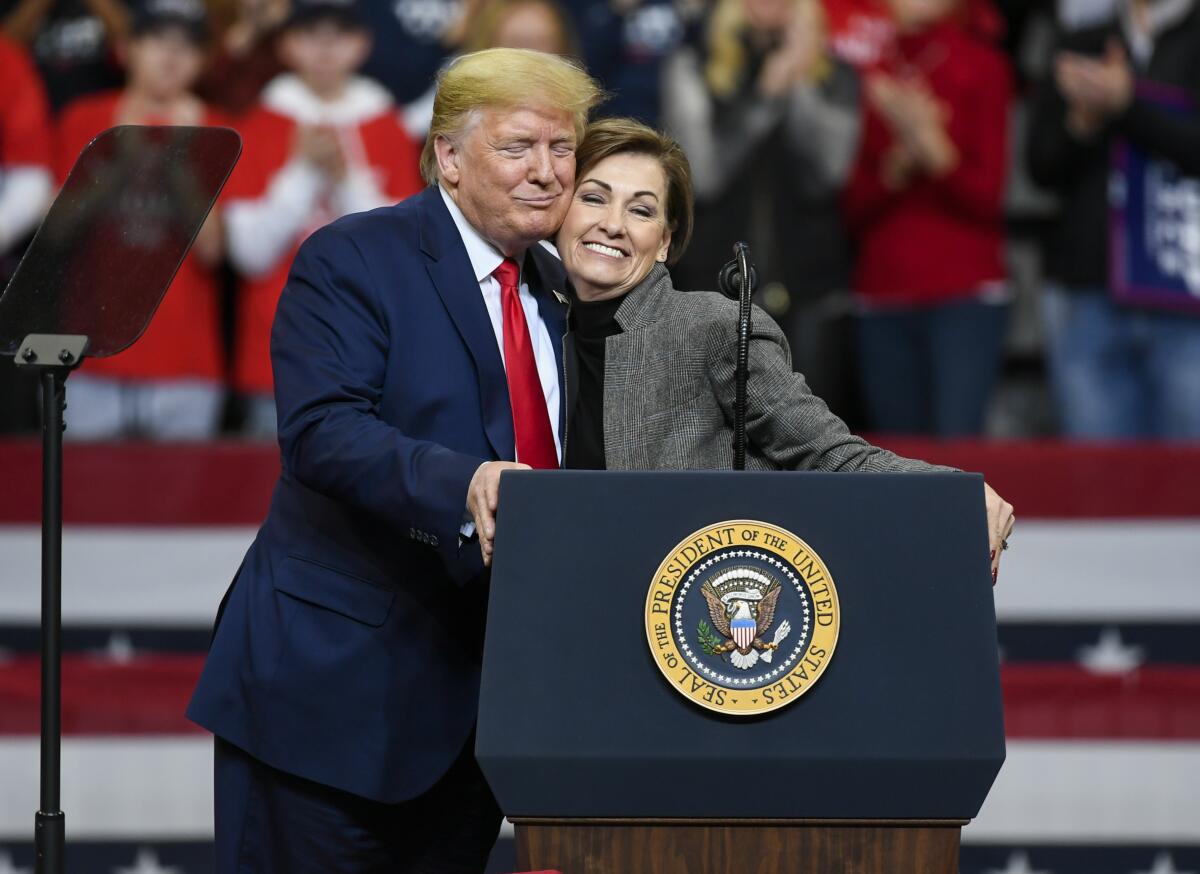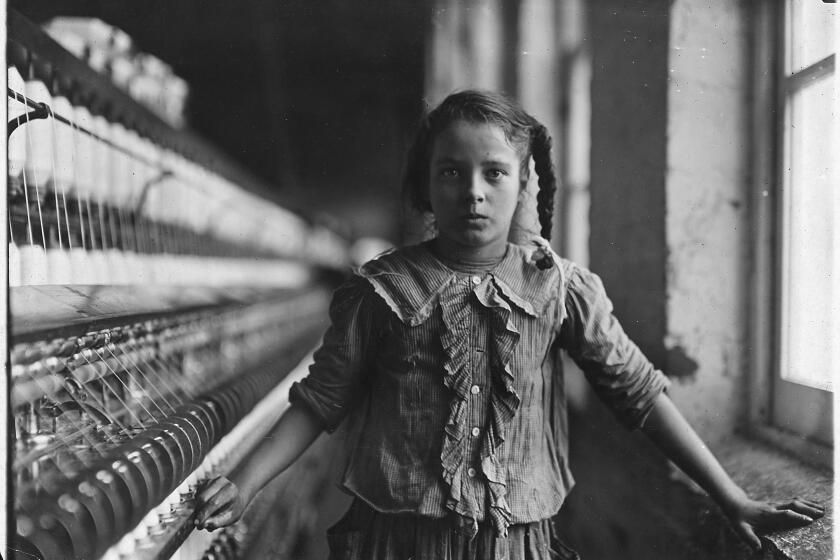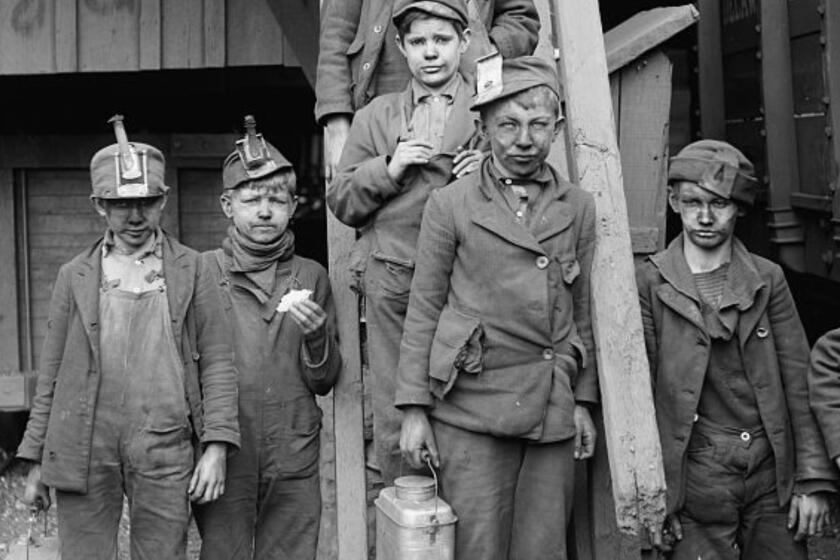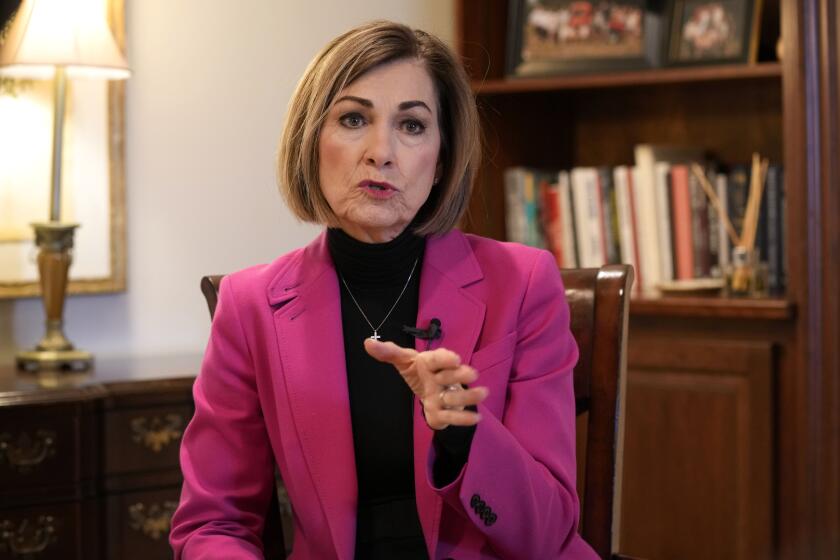Thanks to the Trump slump, Florida and other states are moving to eviscerate child labor protections

- Share via
Florida Gov. Ron DeSantis has discovered a problem with the anti-immigration policies that once made him a GOP star. Luckily he has a solution.
The problem is that chasing immigrant workers out of his state created a labor shortage in some of its most important industries, such as construction, agriculture and tourism.
DeSantis’ solution? Put more kids to work.
This is a coordinated effort being led by a constellation of business lobbying groups and industry associations that would especially benefit from changes in child labor laws.
— Nina Mast, Economic Policy Institute
“What’s wrong with expecting our young people to be able to work part-time?” DeSantis asked during a March 20 appearance with Donald Trump’s immigration czar, Tom Homan, at which he evoked a candy-colored past in which youngsters earned life lessons in the workplace. “That’s how it used to be when I was growing up. Why do we say we need to import foreigners, even import them illegally, when teenagers used to work at these resorts?”
Florida is not the first state to loosen child labor protections, or even the most aggressive in that effort. Last year eight states, all led by Republicans, did so, according to a tracking by the labor-affiliated Economic Policy Institute.
Get the latest from Michael Hiltzik
Commentary on economics and more from a Pulitzer Prize winner.
You may occasionally receive promotional content from the Los Angeles Times.
The most dangerous rollback, by EPI’s reckoning, was enacted by Iowa in 2023. The bill signed by Republican Gov. Kim Reynolds allows teens as young as 14 to work in previously prohibited hazardous jobs in industrial laundries, and those as young as 15 to perform light assembly work.
The measure also allows state agencies to waive restrictions on hazardous work for 16– and 17-year-olds, including demolition, roofing, excavation, and power-driven machine operation. Permissible hours for teens as young as 14 were extended to 9 p.m. from 7 p.m., the federal standard, during the school year. State penalties for violations were reduced.
The drive to reduce child labor restrictions has spread nationwide.
“This is a coordinated effort being led by a constellation of business lobbying groups and industry associations that would especially benefit from changes in child labor laws,” Nina Mast, a child labor expert at the EPI, told an Illinois state senate committee last year.
Republicans are bowing to industry lobbyist in loosening state child labor laws. The inevitable result will be a rise in child deaths in the workplace.
Mast also attributed the effort to “right-wing think tanks and advocacy groups that seek to weaken workers’ rights, erode our social safety net, and threaten the progress we’ve made on equitable access to public education.” (The Illinois Legislature was considering a bill to strengthen child labor protections; the measure was signed into law by Gov. J.B. Pritzker.)
Mast was correct. The trend was endorsed by the authors of Project 2025, the right-wing road map for the current Trump administration. “Some young adults show an interest in inherently dangerous jobs,” the document states. Federal rules prohibiting such employment result in “worker shortages in dangerous fields and often discourages otherwise interested young workers from trying the more dangerous job.” The authors advocated reducing hazard-work regulations to admit teenage workers “with proper training and parental consent.”
In a 2016 article titled “Let the kids work,” the libertarian culture warrior Jeffrey A. Tucker ridiculed the Washington Post for publishing a gallery of work by the great photographer Lewis Hine of child laborers from 100 years ago, including miners and sweatshop workers as young as 10.
Tucker wrote that those children were “working in the adult world, surrounded by cool bustling things and new technology. They are on the streets, in the factories, in the mines, with adults and with peers, learning and doing. They are being valued for what they do, which is to say being valued as people.... Whatever else you want to say about this, it’s an exciting life.”
Children’s advocates are rightfully nervous about the path that child labor law enforcement will take during the Trump administration. Elon Musk’s DOGE operation has moved to sharply cut back the Department of Labor’s enforcement capacity, in part by shuttering 87 of the agency’s offices across the nation, including 37 offices of the agency’s wage and hour division and its Occupational Safety and Health Administration. Those are the two units with most jurisdiction over child labor violations.
It’s also likely that we’ll see a push in Congress to reduce the child labor protections embodied in the Fair Labor Standards Act of 1938. The act preempts state laws that are less stringent than federal law; in those cases, the federal government retains enforcement authority — if it chooses to use it.
Hiltzik: America vanquished the ‘ancient atrocity’ of child labor. Republicans are bringing it back
The moral scourge of child labor was supposedly eradicated in America more than 100 years ago. Red states are bringing it back in the name of parental rights.
“This administration may be more open to looking at Department of Labor prohibitions on hazardous occupations for teens and to pull some of those back,” says Jennifer Sherer, an EPI analyst. “That’s what the weakening of state standards appears to be laying the groundwork for.”
The evils of child labor long have been understood. Franklin Roosevelt aptly referred to it as “this ancient atrocity” in 1933, when he signed a textile industry code that outlawed the employment of children younger than 16 in sweatshops.
Unscrupulous employers, sometimes abetted by state regulators looking the other way, haven’t ceased trying to circumvent the rules. The number of minors that regulators found working under conditions that breached federal law rose by 88%, to 5,792, in fiscal 2023 compared with 2015, according to Labor Department figures, but fell back to 4,030 last year, possibly due to what Sherer called the “proactive approach” to federal enforcement under President Biden. Penalties levied by the agency increased more than tenfold to $15.2 million from 2015 to 2024.
Yet the figures on children working in illegal conditions is likely “the tip of the iceberg,” Sherer told me. Notwithstanding the Biden administration’s efforts, even most federal enforcement was reactive — responses to complaints filed with government authorities. “It’s very clear that most violations don’t get reported.”
The Biden-era Department of Labor pursued some shocking cases of child labor violations, including third-party cleaning contractors that had minors working on overnight shifts at meat and poultry processing plants. From 2019 through 2023, according to government statistics, 49 youths aged 15 or younger and 77 aged 16 or 17 died from workplace injuries.
Pressure to employ minors increased during the pandemic emergency, when labor shortages spread nationwide. An influx of young migrants, unaccompanied or otherwise, may also have exacerbated the problem, because their unfamiliarity with the law and their rights — and their quest for paid jobs — makes them especially vulnerable to unscrupulous employers.
The proponents of loosened child labor laws don’t cite only the need to meet labor demand as a rationale for loosening the rules. They also wrap their proposals in the mantle of parental rights. That was the justification for a law signed in 2023 by Arkansas Gov. Sarah Huckabee Sanders, repealing a rule that required children under the age of 16 to verify their age and obtain the written consent of a parent or guardian before obtaining a work permit. Employers had to provide state officials with a job description and schedule.
Sanders’ office defended the law by stating that obtaining a permit was “an arbitrary burden on parents to get permission from the government for their child to get a job.”
Yet eliminating the requirement for a work permit also eliminates an important source of information for parents about their children’s working conditions. According to a paper published last year, researchers at the University of Maryland found that states with work permit requirements had 15.5% fewer child labor violation cases per million population and 35.2% fewer minors working under illegal conditions than states without such rules.
That brings us back to DeSantis’ Florida.
Iowa and Nebraska reject U.S. money for a summer children’s food program even though the federal government is picking up the tab.
Last year, Florida loosened restrictions on child labor by dropping a 30-hour-per-week limit on work by 16- and 17-year-olds who are home-schooled or have signed permission from a parent or school superintendent; allowing those 16 and 17 to work more than eight hours a day on holidays and Sundays, even if they have school the next day; and allowing them to work more than six days in a row.
A second measure removed a ban on employing those youths on construction sites, though it prohibited allowing them to work on roofs or other structures more than six feet off the ground.
That wasn’t enough for DeSantis, who proposed a further loosening of the rules this year because last year’s measures “did not go far enough to relieve the burdens of employment for this group,” as DeSantis aide Mary Clare Futch told legislative leaders in an email obtained by the Orlando Weekly. The new measure, which is still under consideration by the state Legislature, would eliminate a requirement that those 16 and 17 be given a 30-minute meal break after four hours of work, though it leaves in place the same rule for workers 15 or younger.
The measure would also remove a rule limiting work by 16- and 17-year-olds to the hours between 6:30 a.m. and 11 p.m. or for more than eight hours a day when school is in session and for more than 8 hours a day when school is not in session.
DeSantis’ office explained that its purpose is to align Florida law with federal rules, in order to “provide minors with more flexibility in working” and allow families “to decide what is in the best interest of their child.” Further, the governor’s office said, “working allows children to learn valuable soft skills that will help them be successful.”
In Florida, where almost 28% of all jobs are held by immigrants, the industry with the highest concentration of immigrant labor isn’t the resort industry but construction, in which 11.1% of employees are foreign-born.
I asked DeSantis’ office if he wasn’t sugarcoating the employment demand for young workers by referring to resorts rather than construction. I also asked what jobs he held when he was “growing up.” I didn’t receive a reply to either question.
As I’ve written before, the rollback of child labor protections isn’t a matter of streamlining unnecessary regulations. It’s a moral test for America. Some states have already flunked, but unfortunately they may not be the last to bring this ancient atrocity back to life.
More to Read
Insights
L.A. Times Insights delivers AI-generated analysis on Voices content to offer all points of view. Insights does not appear on any news articles.
Viewpoint
Perspectives
The following AI-generated content is powered by Perplexity. The Los Angeles Times editorial staff does not create or edit the content.
Ideas expressed in the piece
- The article argues that Florida’s push to roll back child labor laws, including proposals like SB 918 and HB 1225, is a response to labor shortages exacerbated by anti-immigration policies, particularly in industries like construction and agriculture[3]. Critics claim these changes prioritize business interests over child safety, risking exploitation and hazardous working conditions for minors[3].
- Looser restrictions are framed as part of a broader national trend led by conservative groups and business lobbies seeking to weaken worker protections, with references to Iowa’s 2023 law allowing teens to work in dangerous roles like roofing and demolition[3].
- Enforcement concerns are highlighted, including reduced federal oversight under the Trump administration and the closure of Department of Labor offices, which could lead to underreporting of violations[3].
Different views on the topic
- Proponents, including bill sponsors, argue the changes align Florida’s laws with federal standards and provide flexibility for families, emphasizing parental rights to decide work schedules for their children[2][3]. For example, SB 918 removes restrictions on 16- and 17-year-olds’ work hours during school nights and waives requirements for mandated breaks[2][3].
- Supporters claim the reforms teach “valuable soft skills” and focus on safer sectors like retail (e.g., Publix supermarkets), rejecting comparisons to hazardous industrial jobs[3][1]. Amendments to allow 13-year-olds to work during summers are framed as limited exceptions with parental oversight[1].
- Advocates dismiss concerns about exploitation, stating the bills modernize outdated rules and address workforce needs without compromising safety, citing existing federal safeguards for hazardous occupations[2][3].
Get the latest from Michael Hiltzik
Commentary on economics and more from a Pulitzer Prize winner.
You may occasionally receive promotional content from the Los Angeles Times.














